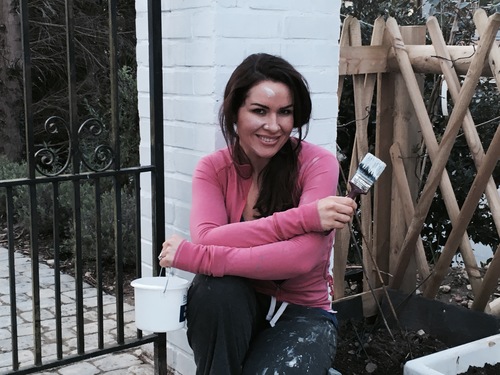Expert Advice on Interior Changes to Make to Maximise Positive Mental Health
• Interiors are vitally important in supporting positive mental health.
• Presenter and DIY expert Georgina Burnett gives her top interior tips on how to support and maximise positive mental health and wellbeing.
With one in four expected to suffer from a mental illness each year; creating a comfortable, peaceful and personalised space is being recognised as a powerful tool in relieving feelings of anxiety, depression and Seasonal Defective Disorder. New research conducted by National Home Improvement Month has unveiled that currently, 52% of the UK feel uncomfortable in their own homes, 63% feel unsafe and 10% feel embarrassed or ashamed.
Presenter, interior designer, and National Home Improvement Month Ambassador Georgina Burnett provide her top small interior changes, to alleviate stresses and promote positive wellbeing.
Decluttering
Georgina Burnett advises that one of the easiest and most effective interior changes to make is creating a more spacious and simpler environment:
“Your home needs to represent where you want to be or where you want to move towards in life, so you need empowering interiors to propel you forward. The first step must be to declutter, as an organised home means an organised mind”, says Georgina.
“Removing excess clutter from mantelpieces, shelves and the tops of cupboards and storing in attics or under beds creates a minimalistic space that appears larger. The interior instantly becomes a more soothing and relaxing space, losing its overwhelming and demanding aura.”
Upcycling
Georgina warns that an environment that includes damage or broken furniture can subconsciously impact wellbeing and mood. As Georgina notes: “your furniture may have seen better days. Maybe you have been clinging onto it for far too long. You could replace it and send the old items to charity, or even better upcycle. You would be amazed by what you can do with some chalk paint and decoupage – and it will save you money! Fix anything that is broken. Feng Shui warns us that broken, cracked and faulty items in the home will affect our chi.”
Greenery
Georgina suggests incorporating plants, flowers, and greenery into interior design to improve wellbeing.
As Georgina describes: “According to many studies, indoor plants have been shown to improve your mood, reduce stress levels, increase productivity, attention span and even pain tolerance.”
“For me, a room isn’t finished until it has at least one plant in it. It’s a great way to soften edges and bring a corner to life. The popularity of house plants has returned in force recently - particularly big leafy plants like the Monstera, mirrored in fashionable wallpapers and fabrics. A deep green plant can not only add depth to the en vogue pastel schemes but can also help your wellbeing. If you want big impact plants though, Schefflera, otherwise known as Umbrella plant, Dracaena, Yukka and Devil’s Ivy (Epipremnum aureum) are all great options for the home. To improve air quality incorporate for Areca Palm (Chrysalidocarpus lutescens), Lady Palm (Rhapis excelsa), Bamboo palm (Chamaedorea seifrizii) or Rubber Plant (Ficus robusta) as these are great for removing formaldehyde, benzene, and carbon monoxide from the air.”
“These days there are some incredible faux plants too which can have a placebo effect on lifting the mood of the less green-fingered amongst us. Very popular at the moment are succulents. These pretty and interesting species take very little care - needing just the odd spritz with a water spray and can make for beautiful displays, even vertical wall art.”
Colour
Colour psychology is a fascinating subject and is a really helpful guide for working out which colours will bring about the appropriate mood for a room. Remember that colour is almost as divisive as Brexit though, so it’s a conversation to be had with all members of the household! For example, some people find that yellow lifts their mood, whilst it makes others feel uneasy. I’ve experimented with clients by using a heart rate monitor whilst holding up colour cards in front of them, with astonishing results. So play around with colours and assess how they make you and your family feel – then use what you find to help you choose the appropriate colour scheme for each room.
For more tips, advice on DIY and home improvements visit the National Home Improvement Month website at: http://www.homeimprovementmonth.co.uk/
- Ends –
1- https://www.mind.org.uk/information-support/types-of-mental-...
For further information, images or a copy of the full research, please contact Amy Boreham on 020 3958 7195 or email Amy@kincomms.com or Thomas Gabbidon at Thomas@kincomms.com
NOTES FOR EDITORS
National Home Improvement Month is supported by the British Home Enhancement Trade Association (BHETA), the leading UK trade association for manufacturers, suppliers and distributors in the home enhancement market, including home improvement (DIY), garden, housewares and small electricals.
ABOUT THE RESEARCH
The research was carried out online from 15-19 November 2018 by Vital Research on behalf of BHETA. The research sample comprised 2,001 UK home owners. All research conducted adheres to the UK Market Research Society (MRS) code of conduct (2014) and all research processes comply with the DPA (1998).
OFFICIAL AMBASSADORS
More information on the official ambassadors is available via the respective websites for Julia Kendell and Georgina Burnett
